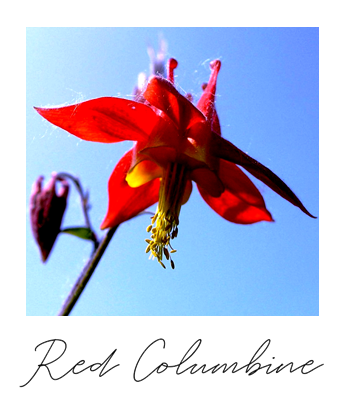
Download .pdf version
Columbia, SC--In March, a native and vibrant wildflower begins to spin and dance in floral gardens and woodlands throughout the eastern region of North America. Many say that the bell-shaped petals of the red columbine resemble tiny ballerinas and add movement to any garden. Their delicate nature is contrasted by their boldly-colored red and yellow petals, which are pedestaled by red stems with bluish-green leaves. The spurred flowers of red columbine are also said to resemble an eagle’s talon, perhaps inspiring the scientific name of Aquilegia canadensis. (Aquilegia comes from the Latin word aquila, which means “eagle.”)
The tube-shaped bases of red columbine flowers are full of nectar that attracts a wide variety of hummingbirds and butterflies. The nectar of the red columbine has twice the sugar content of all other columbine flowers in North America, making it a favorite of hummingbirds and other long-tongued pollinators. Still, it is common to find tiny holes along the spurred-petals that insects without long tongues have drilled to help themselves to the irresistible nectar full of necessary amino acids. Humans can also sample this sweet nectar; the flower of the red columbine is reportedly edible and is sometimes used as a garnish in salads. However, the stem and leaves of the flower contain toxins that could disrupt the digestive system.
Though some parts of the plant could be toxic in large amounts, red columbine has a medicinal history, too. Native Americans used infusions of the flower to treat heart, bladder, and kidney conditions, and as a remedy for headaches and fevers. It was even turned into a wash to treat poison ivy. Native American men would crush the plant’s seeds and cover their hands in the powder as a charm to entice romantic partners. The sweet smell of the red columbine can be concentrated into perfumes and tobacco products. This plant clearly serves many purposes beyond its beauty.
Red columbine is a short-lived perennial wildflower that blooms from March to July and can grow between two and three feet tall. It prefers filtered sun exposure and a moist spring soil that dries out during the summer, but it can tolerate full sun to full shade conditions, along with varying soil moistures. It self-sows its seeds that resemble black pearls. The seeds bounce when they hit the ground, which makes it easier for the seed to naturally spread. The wildflower can overpower weeds in a garden, and most deer will leave it alone. To grow red columbine, simply scatter seed in bare parts of a garden or in outdoor pots beginning in the fall or winter. Within one or two seasons, the twirling flowers of red columbine will dance around any garden and will encourage pollinators to do the same.
Red columbine is one of the many flowers growing in Pinewood Lake Park’s pollinator garden, as it is a favorite among buzzing pollinators, like the ruby-throated hummingbird. Pinewood Lake Park is located in Richland County off of Old Garners Ferry Road, and the pollinator garden is normally open to public visitation throughout the year. Temporary closures are expected as our community deals with the global outbreak of Covid-19.
References: U.S. Forest Service, U.S. Department of Agriculture, University of Texas
Download .pdf version
# # #
Conservation Districts are political subdivisions of state government under the local direction of five-member Boards of Commissioners. In South Carolina, Conservation District boundaries conform to County boundaries. The Richland Soil and Water Conservation District promotes the wise use and care of natural resources for long-term sustainability.
Contact
Richland Soil and Water Conservation District
2020 Hampton Street, Room 3063A
Columbia, SC 29204
Phone (803) 576-2080
Fax (803) 576-2088
E-mail soilandwater@rcgov.us
Facebook www.facebook.com/rswcd